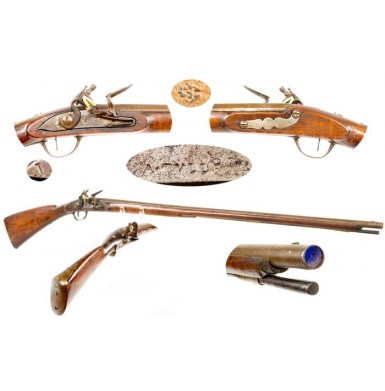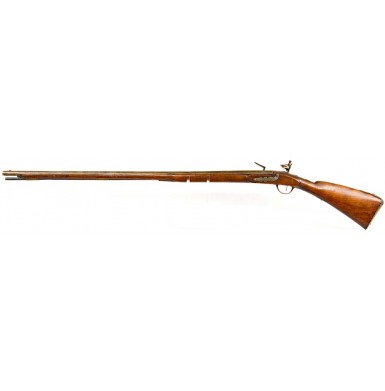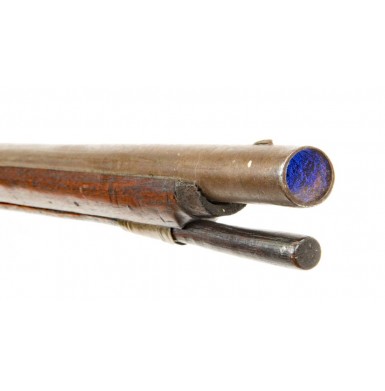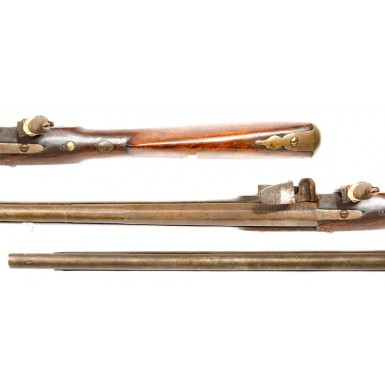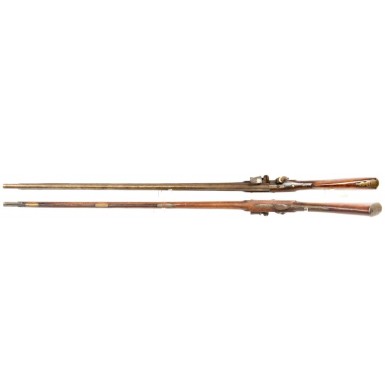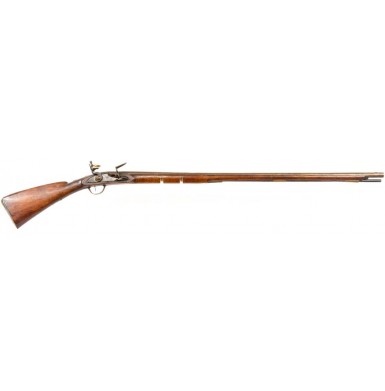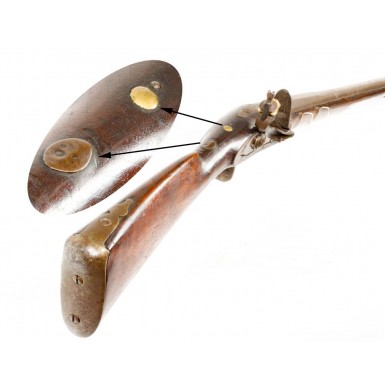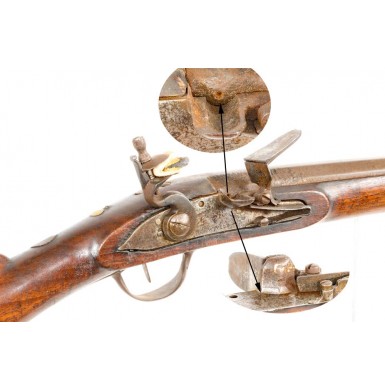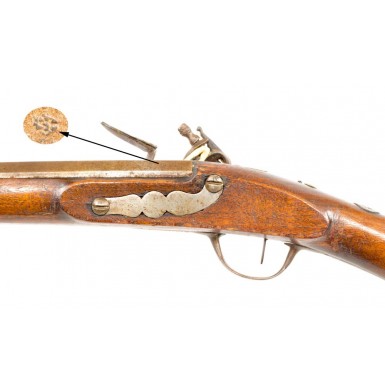American Restocked French Fusil de Chasse
- Product Code: FLA-3464-SOLD
- Availability: Out Of Stock
-
$1.00
During the first half of the 18th century, few long arms were more representative of the guns carried in the woods of much of North America than the French “Fusil de Chasse”, literally meaning “hunting gun”. The “fusil de chasse”, along with its contemporaries the “fusil de traite” (trade gun) and the “fusil de fin” (fine gun, a higher-grade trade gun with more ornamentation), were differentiated from the gun they had been derived from, the “fusil ordinaire” (“ordinary” or “typical” gun), by a number of features that adapted them to their purpose. The Fusil Ordinaire was the standard French infantry musket of the period. While the French had been providing hunting and trade guns to the North American continent since the 1600s, these guns often differed little from the French military arms then in use, and realistically there was little uniformity in pattern or design for either the military or trade arms. During the last decade of the 17th century and the first decade of the 18th century, the French attempt to begin standardizing patterns of arms, both for military use and eventually for economic and diplomatic use in trade. During the period when some of the first standardized French hunting and trade fusils were being produced, the gun that was their inspiration was the French Model 1717 musket. The M1717 was long, heavy and well designed to serve as a combat musket for that period. It was nominally 63” in overall length, with a 46 ¾” .69 caliber smoothbore barrel. It was not short, light and handy and thus was poorly suited for use in the thickly wooded areas of North America. The French solution was to produce a shortened and lightened version of the guns, usually with an overall length of 60” or less. The barrels of the fusils were typically between 42”-46” long, the caliber was reduced to around .60-.62 and most importantly the stocks were thinned and slimmed, making the guns sleek and handy. These lighter guns often weighed about 2/3 of the weight of the comparable pattern military musket, were much better balanced and had a graceful sloping line to the butt, referred to by the French as a “pied a vache” (“cow’s foot”) design. In English, this distinctive French butt shape became known as the Roman Nose pattern. A graceful design so aesthetically pleasing and functional, it would become one of the features most associated with American gun makers of the 18th and 19th centuries and would be found incorporated into the designs of colonial era musket fowlers from New England to Golden Age Kentucky Rifles from Pennsylvania. The French fusils were usually cheaply made, with pinned barrels, simple furniture and simple locks. Locks tended to be flat, with unbridled pans and flat swan neck cocks without reinforcement. Starting in the early 1700s, many of the guns were produced at the French arsenal at Tulle and are found marked A TVLLE on the lock, along with various French inspections on the barrels. The guns were also produced by French contractors as well as Liège based gun makers. The light-weight barrels were almost universally octagon-to-round in profile, with a nominally 9”-11” long octagonal section that featured baluster turned rings and incised lines at the transition to round. Although originally stocked fully to the muzzle, by the 1740s the guns were often being modified by cutting back the forend 2”-3” and adding a bayonet lug to accept a socket bayonet. The cut back stock was usually reinforced with a thin band of brass near the tip or even with a metal stock tip to prevent cracking. This modification turned the handy hunting guns into dual purpose musket fowlers, perfect for hunting or ersatz military use. Many of the French irregular and militia troops who fought during the French and Indian War carried fusils modified in exactly this way. Although the guns were perfectly designed to be light and handy in the wilderness, they were resultantly weak as well. Stocks in particular were prone to breakage, resulting in a cottage industry of gunsmiths, woodworkers and blacksmiths who spent at least part of their time repairing or restocking French fusils to keep them functional. It was not uncommon for the metal from French arms, particularly locks and barrels, to be found incorporated into American assembled arms that were many decades newer than some of their oldest French components. In some cases, these repurposed components remained in use into the early part of the 19th century, with some of the parts approaching the centennial of their working lives before they were finally abandoned. There was probably an economic incentive to the design as well. As the guns were cheaply made in many respects and did not hold up to arduous use in the wilderness, this meant that the users had to obtain new guns with some regularity; if they could not get the guns repaired. This was particularly true of the guns traded to the Natives of North America, who did not have ready access to skilled tradesmen to repair their guns. Thus, after a few hunting seasons of use, the Native hunter was often trading more pelts for another trade fusil that would again wear out fairly soon, creating a never-ending cycle of trade that was most beneficial to the Europeans. Despite the huge numbers of French hunting and trade fusils that came to the North American continent during the 18th century, their survival rate is fairly low today. These were inexpensive working guns that were intended to be somewhat disposable, thus they were typically used up and worn out. Finding an original configuration French fusil de chasse is quite difficult, as very few survive without some level of modification. What can be obtained somewhat more easily is one of the “assembled” fusils, guns repaired, restocked or otherwise modified from their original configuration during their working life to either keep them functional, or to more closely fill the needs of their user. Most of these guns are American assembled pieces, very often guns left over or captured as part of the Anglo-American victory in the French and Indian War. Often these guns were still in use in American households some two decades later when the American Revolution erupted. As such, an American assembled or modified French fusil is a wonderful way to represent a weapon that could well have seen use during both the French and Indian War as well as during the early days of the American Revolution. Offered here is a very attractive, solid example of an American Restocked French Fusil de Chasse. The gun has been shortened slightly as part of the process, making it an even handier and more effective North American woods gun. The gun measures 54” in overall length, with a 38 7/16” long octagon-to-round pinned barrel with the expected baluster turned rings and incised lines at the transition. The transition takes place about 11 7/8” from the breech with the flats measuring about 9”. The bore of the gun is smooth and measures .61”, right in the middle of the .60”-62” caliber bores that are most often found on these fusils. The gun is stocked to within 2” of the muzzle, suggesting that it may have been intended to accept a bayonet at some point in time, although no remnant of a lug is visible. The forend tip was formerly reinforced with a ½” wide piece of sheet brass, but this piece is lost to the ages. A rather crude, copper (or red brass) front sight is applied to the top of the barrel, .815” from the muzzle, and measuring .4” in length. The gun has a flat, iron lock that measures nominally 6” in length and terminates in a pronounced teat. The lock has an integral faceted, unbridled, fenced iron pan and a flat swan neck cock. The lock is marked A. TVLLE below the pan and with the letter J at its tail. A French touch mark that appears to be a superposed TM is present on the left angled barrel flat as well. No other markings are present on the exterior of the gun. With the exception of the two sheet brass ramrod thimbles, all of the furniture of the gun is all of simple sheet iron, including the iron entry pipe. The 3 ½” flat iron side plate is a classic example of the standard Tulle Arsenal fusil side plate. The triggerguard is 10 ½” in length and is a simplified and cruder version of the French M1717 – M1728 period triggerguard, with the tips of the finals cut off squarely. The buttplate is even more simple with a nominally 3” tang. It is secured by three screws. The screws, particularly the two lock mounting screws and the breech plug tang screw are incredibly crude, handmade pieces with squared, hand-cut shafts that terminate in somewhat crudely cut threads. The stock is of American origin and retains the distinctive Roman nosed profile of French fusil stocks, with a graceful 4 ¼” drop at the comb and a relatively short 12 ½” length of pull from the center of the buttplate to the flat iron trigger. While the butt retains the basis of the graceful French lines, they are executed in a very workman like fashion and overall the stock is slightly blockier and sturdier than an original French stock. There is no pronounced rail to the butt, nor is the wrist long and slender, rather it is short and somewhat blocky. This may indicate the workman wanted the gun to be a little stronger and more practical for use in a harsh environment, or it may simply indicate a lack of artistic vision or capability. The entire guns is stocked in very functional way, with the inletting of the metal to the wood is acceptable but showing no great skill or artistry. The shape of the lock mortise and counterpane are more typical of very late 18th or early 19th century gun stocking, suggesting that this work may be more Federal Era than Revolutionary War period. The gun is very handy and well balanced, weighing in at a little over 6lbs, about 2/3 the weight of period musket. The gun remains in about VERY GOOD condition, as modified during the period of use. The iron components show light to moderate oxidation with a thin brown patina over the pewter base color of the metal. The barrel shows some lightly scattered pitting over most of its length, with moderate and even aggressive pitting around the breech area. The touchhole shows moderate erosion but no indication of re-conversion. It remains well centered in the pan and is appropriately angled and tapered. The lock shows light to moderate pitting as well, with the heaviest pitting being in the pan and around that part of the lock. The lock remains functional but does show some damage and wear. The interior of the lock is marked 16 as is the bridle. The mainspring is an old replacement, likely from the period of use. Several of the screws are replaced as well, no doubt due to wear and damage during their life. The lock remains in its original flintlock configuration with the original iron pan that has not been rewelded or reattached to the lock plate. The steel (frizzen) is worn, with an old refacing that is chipped at the tip and shows heavy use. The frizzen fits the pan somewhat awkwardly, but this appears to be because the unsupported frizzen screw may be bent, thus throwing the geometry of the steel off. This apparent damage is why a bridled pan is important, as it provides support for the steel screw. If the frizzen is replaced it was done during the period of use, as all of the wear patterns suggest that it has been with the gun since that time. The cock shows an old welded repair in its neck, a common issued for a swan neck cock and the reason why the reinforced cock was adopted almost universally for military arms. The top jaw and screw are old replacements, possibly from the period of use, but possibly later as well. The iron furniture has a patina that matches the barrel and lock well. The two brass ramrod thimbles have an uncleaned patina, the upper one with a short crack in it. An old wooden ramrod is present in the ramrod channel. It shows good age and some nice wear, but it is impossible to determine when it was mated to the gun. The bore of the gun is in about GOOD condition. It shows heavy oxidation, is dark and dirty and appears to be moderately to severely pitted along its length. The stock remains solid with no breaks or repairs. It does show some chipping around the lock mortise and numerous small grain cracks, both externally and internally. Mostly notably are a couple of surface grain cracks around the lock mortise and several more in the rammer channel and on the interior of the lock mortise. All appear solid and stable and are really just signs of age, use and wear. The stock shows no signs of sanding with good edges, but does show numerous scattered bumps, dings and mars. In particular there is a cluster of small dings and mars on the reverse behind the counterpane and on the reverse of the forend behind the middle pipe. A roughly ¾” long but ½” wide iron oval thumb piece is set into the wrist of the stock, as is a brass tack with a .4” diameter head and small handmade finishing nail. The meaning or intent of the decorations is unknown. Overall this is a really attractive and very interesting American Restocked French Fusil de Chasse that remains in original flint and started life as a French Tulle Arsenal trade or hunting fusil for the North American market. It is hard to know exactly when the gun was restocked, but the styling suggests circa 1790-1810, although it could be earlier. The lock and barrel as well as some of the furniture are almost certainly circa 1730-1750, with some of the furniture (primarily to two brass pipes, the buttplate and possibly the triggerguard) somewhat later, and possible American made. These American composite guns have a truly interesting history, as they went through numerous repairs and even complete rebuilds to keep them functional and is service. Most of the components for this gun were certainly in service during the period of the French and Indian War, and it is likely the gun saw some early Revolutionary War service as well, but not likely with this stock. The stock allowed the gun to remain in use into the period of the 19th century, and possibly to the period of the War of 1812, although it is unlikely that saw any military use at that time. The gun came out of Western North Carolina, but no further information about use or history is available. This is certainly a very interesting and attractive Americanized French Fusil that would be a nice addition to any collection of flintlock long arms. SOLD |

